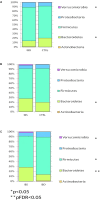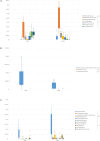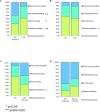Fecal and Mucosal Microbiota Profiling in Irritable Bowel Syndrome and Inflammatory Bowel Disease
- PMID: 31379797
- PMCID: PMC6650632
- DOI: 10.3389/fmicb.2019.01655
Fecal and Mucosal Microbiota Profiling in Irritable Bowel Syndrome and Inflammatory Bowel Disease
Abstract
An imbalance in the bacterial species resulting in the loss of intestinal homeostasis has been described in inflammatory bowel diseases (IBD) and irritable bowel syndrome (IBS). In this prospective study, we investigated whether IBD and IBS patients exhibit specific changes in richness and distribution of fecal and mucosal-associated microbiota. Additionally, we assessed potential 16S rRNA gene amplicons biomarkers for IBD, IBS, and controls (CTRLs) by comparison of taxonomic composition. The relative abundance of bacteria, at phylum and genus/species levels, and the bacterial diversity were determined through 16S rRNA sequence-based fecal and mucosal microbiota analysis. Linear discriminant analysis effect size (LEfSe) was used for biomarker discovery associated to IBD and IBS as compared to CTRLs. In fecal and mucosal samples, the microbiota richness was characterized by a microbial diversity reduction, going from CTRLs to IBS to IBD. β-diversity analysis showed a clear separation between IBD and CTRLs and between IBD and IBS with no significant separation between IBS and CTRLs. β-diversity showed a clear separation between mucosa and stool samples in all the groups. In IBD, there was no difference between inflamed and not inflamed mucosa. Based upon the LEfSe data, the Anaerostipes and Ruminococcaceae were identified as the most differentially abundant bacterial taxa in CTRLs. Erysipelotrichi was identified as potential biomarker for IBS, while Gammaproteobacteria, Enterococcus, and Enterococcaceae for IBD. This study provides an overview of the alterations of microbiota and may aid in identifying potential 16S rRNA gene amplicons mucosal biomarkers for IBD and IBS.
Keywords: dysbiosis; gut microbiota; inflammation; inflammatory bowel disease; irritable bowel syndrome.
Figures





Similar articles
-
Gut microbiota in mucosa and feces of newly diagnosed, treatment-naïve adult inflammatory bowel disease and irritable bowel syndrome patients.Gut Microbes. 2022 Jan-Dec;14(1):2083419. doi: 10.1080/19490976.2022.2083419. Gut Microbes. 2022. PMID: 35695669 Free PMC article.
-
Fecal and mucosal microbiota profiling in pediatric inflammatory bowel diseases.Eur J Gastroenterol Hepatol. 2021 Nov 1;33(11):1376-1386. doi: 10.1097/MEG.0000000000002050. Eur J Gastroenterol Hepatol. 2021. PMID: 33470709
-
Phylogenetic analysis of Prevotella copri from fecal and mucosal microbiota of IBS and IBD patients.Therap Adv Gastroenterol. 2023 Jan 10;16:17562848221136328. doi: 10.1177/17562848221136328. eCollection 2023. Therap Adv Gastroenterol. 2023. PMID: 36644130 Free PMC article.
-
Alterations of Gut Microbiota in Patients With Irritable Bowel Syndrome Based on 16S rRNA-Targeted Sequencing: A Systematic Review.Clin Transl Gastroenterol. 2019 Feb;10(2):e00012. doi: 10.14309/ctg.0000000000000012. Clin Transl Gastroenterol. 2019. PMID: 30829919 Free PMC article.
-
A Systematic Review: Fecal Bacterial Profile in Patients with Irritable Bowel Syndrome Analyzed with the GA-Map Dysbiosis Test Based on the 16S rRNA Gene of Bacterial Species or Groups.Clin Exp Gastroenterol. 2024 Apr 17;17:109-120. doi: 10.2147/CEG.S451675. eCollection 2024. Clin Exp Gastroenterol. 2024. PMID: 38646157 Free PMC article. Review.
Cited by
-
Lactobacillus rhamnosus Attenuates Cisplatin-Induced Intestinal Mucositis in Mice via Modulating the Gut Microbiota and Improving Intestinal Inflammation.Pathogens. 2023 Nov 11;12(11):1340. doi: 10.3390/pathogens12111340. Pathogens. 2023. PMID: 38003804 Free PMC article.
-
Fecal microbiota transplantation influences microbiota without connection to symptom relief in irritable bowel syndrome patients.NPJ Biofilms Microbiomes. 2024 Aug 28;10(1):73. doi: 10.1038/s41522-024-00549-x. NPJ Biofilms Microbiomes. 2024. PMID: 39191760 Free PMC article. Clinical Trial.
-
Going Beyond Bacteria: Uncovering the Role of Archaeome and Mycobiome in Inflammatory Bowel Disease.Front Physiol. 2021 Dec 6;12:783295. doi: 10.3389/fphys.2021.783295. eCollection 2021. Front Physiol. 2021. PMID: 34938203 Free PMC article. Review.
-
Alterations in Gut Microbiome Composition and Function in Irritable Bowel Syndrome and Increased Probiotic Abundance with Daily Supplementation.mSystems. 2021 Dec 21;6(6):e0121521. doi: 10.1128/mSystems.01215-21. Epub 2021 Nov 2. mSystems. 2021. PMID: 34726487 Free PMC article.
-
Constipation-Predominant Irritable Bowel Syndrome (IBS-C): Effects of Different Nutritional Patterns on Intestinal Dysbiosis and Symptoms.Nutrients. 2023 Mar 28;15(7):1647. doi: 10.3390/nu15071647. Nutrients. 2023. PMID: 37049488 Free PMC article. Review.
References
-
- Baumgart M., Dogan B., Rishniw M., Weitzman G., Bosworth B., Yantiss R., et al. (2007). Culture independent analysis of ileal mucosa reveals a selective increase in invasive Escherichia coli of novel phylogeny relative to depletion of Clostridiales in Crohn’s disease involving the ileum. ISME J. 1 403–418. 10.1038/ismej.2007.52 - DOI - PubMed
LinkOut - more resources
Full Text Sources
Other Literature Sources

